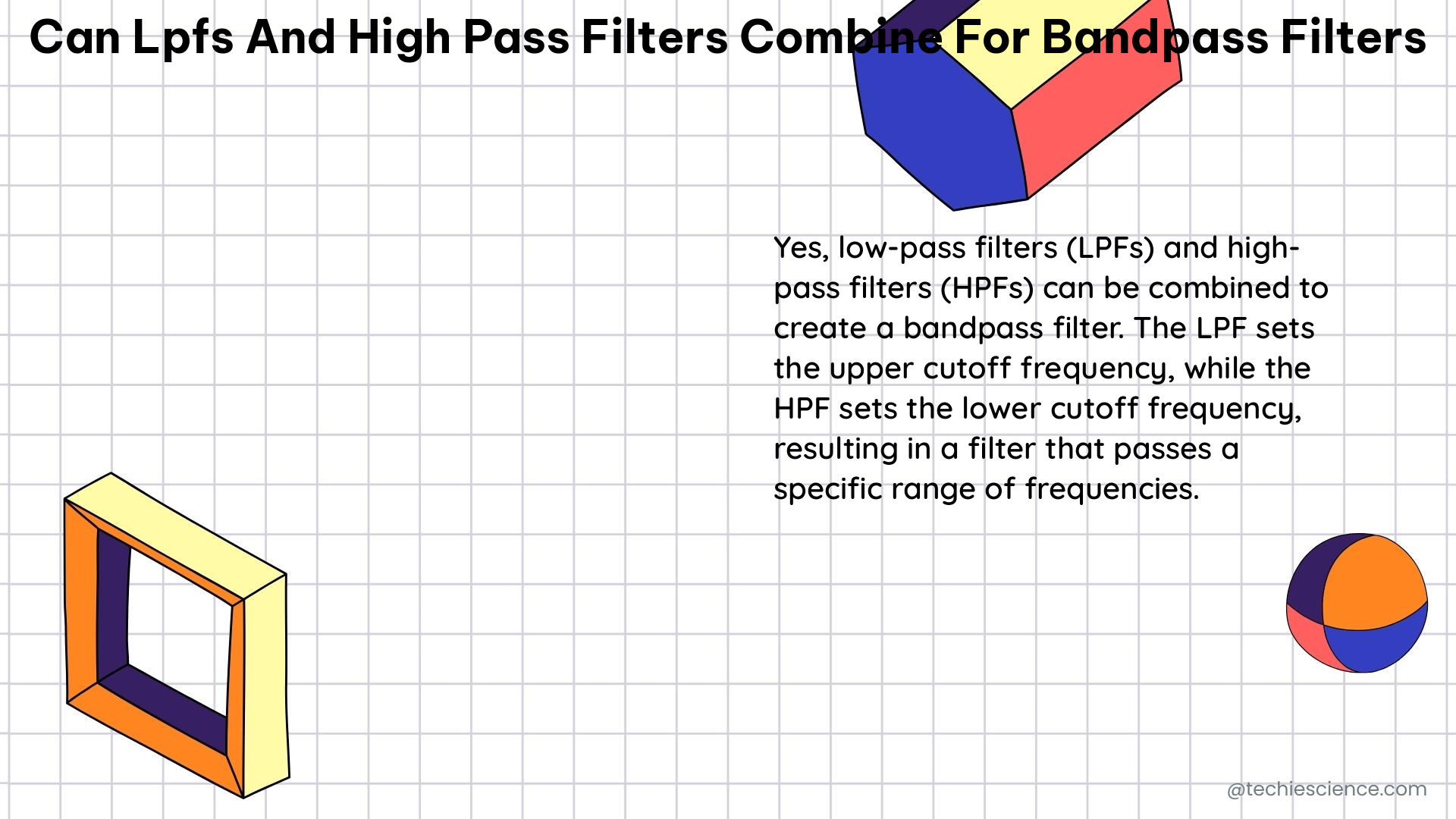Bandpass filters (BPFs) are essential components in various electronic circuits, from radio frequency (RF) systems to audio processing applications. One effective method of constructing a BPF is by combining low-pass filters (LPFs) and high-pass filters (HPFs) in a cascaded configuration. This approach allows for the creation of wide-band bandpass filters with customizable center frequencies and bandwidths.
Understanding the Basics of LPFs, HPFs, and BPFs
Low-pass filters (LPFs) are electronic circuits that allow low-frequency signals to pass through while attenuating high-frequency signals. Conversely, high-pass filters (HPFs) allow high-frequency signals to pass through while attenuating low-frequency signals. By cascading an LPF with a high cutoff frequency (f2) and an HPF with a low cutoff frequency (f1), a bandpass filter (BPF) can be created, with a frequency response between f1 and f2.
Designing a Bandpass Filter Using Cascaded LPF and HPF Stages

The process of designing a BPF using cascaded LPF and HPF stages involves several key steps:
-
Determining the Cutoff Frequencies: The cutoff frequencies of the LPF (f2) and HPF (f1) should be selected to achieve the desired center frequency (fc) and bandwidth (B) of the BPF.
-
For a wide-band pass filter, the center frequency (fc) is the geometric mean of f1 and f2:
fc = √(f1 × f2) - For a narrow-band pass filter, the center frequency (fc) is the average of f1 and f2:
fc = (f1 + f2) / 2 -
The bandwidth (B) of the BPF is given by the equation:
B = f2 - f1 -
Calculating the Quality Factor (Q): The quality factor (Q) of a BPF is a measure of its selectivity and is calculated as:
Q = fc / B -
Ensuring Adequate Separation between f1 and f2: When designing a BPF using cascaded LPF and HPF stages, it is crucial to ensure that there is at least a decade (10x) difference between f1 and f2 to avoid loading effects between the stages. This method is suitable for wide-band BPFs, while parallel and series resonant BPFs are more suitable for narrow-band BPFs.
-
Considering LPF and HPF Specifications: When combining LPF and HPF stages, the pass-band insertion loss and stop-band attenuation specifications of the LPF should be considered to ensure that the combined BPF meets the desired performance criteria.
Practical Considerations and Design Examples
- Wide-Band Bandpass Filter Design:
- Example: Designing a BPF with a center frequency of 1 MHz and a bandwidth of 500 kHz
- Cutoff frequencies: f1 = 750 kHz, f2 = 1.25 MHz
- Center frequency (fc) = √(750 kHz × 1.25 MHz) = 1 MHz
- Bandwidth (B) = 1.25 MHz – 750 kHz = 500 kHz
-
Quality factor (Q) = 1 MHz / 500 kHz = 2
-
Narrow-Band Bandpass Filter Design:
- Example: Designing a BPF with a center frequency of 10 MHz and a bandwidth of 1 MHz
- Cutoff frequencies: f1 = 9.5 MHz, f2 = 10.5 MHz
- Center frequency (fc) = (9.5 MHz + 10.5 MHz) / 2 = 10 MHz
- Bandwidth (B) = 10.5 MHz – 9.5 MHz = 1 MHz
-
Quality factor (Q) = 10 MHz / 1 MHz = 10
-
Cascaded LPF and HPF Design Considerations:
- Ensure at least a decade (10x) difference between f1 and f2 to avoid loading effects
- Consider the pass-band insertion loss and stop-band attenuation specifications of the LPF
- Optimize the filter order and component values to meet the desired performance criteria
Applications and Use Cases
Bandpass filters created by combining LPFs and HPFs find applications in various electronic systems, including:
- Radio frequency (RF) circuits: Filtering and selecting specific frequency bands in wireless communication systems
- Audio processing: Isolating specific frequency ranges for audio equalization and signal processing
- Instrumentation and measurement: Filtering out unwanted frequency components in test and measurement equipment
- Power electronics: Filtering harmonics and noise in power conversion circuits
Conclusion
Combining low-pass filters (LPFs) and high-pass filters (HPFs) is a versatile and effective method for creating bandpass filters (BPFs) with customizable center frequencies and bandwidths. By understanding the design principles, practical considerations, and design examples, electronics engineers and enthusiasts can effectively utilize this technique to construct wide-band and narrow-band bandpass filters for a variety of applications.
Reference:
- EEPower: How to Create Bandpass Filters – Technical Articles
- RF Page: Low Pass, High Pass and Band Pass Filters – Simple Explanation
- Reddit: How to combine a low pass and high pass filter into bandpass filter
- Electronics Tutorials: Passive Band Pass Filter
- ResearchGate: First Demonstration of Compact, Ultra-Thin Low-Pass and Bandpass Filters for 5G Small-Cell Applications

The lambdageeks.com Core SME Team is a group of experienced subject matter experts from diverse scientific and technical fields including Physics, Chemistry, Technology,Electronics & Electrical Engineering, Automotive, Mechanical Engineering. Our team collaborates to create high-quality, well-researched articles on a wide range of science and technology topics for the lambdageeks.com website.
All Our Senior SME are having more than 7 Years of experience in the respective fields . They are either Working Industry Professionals or assocaited With different Universities. Refer Our Authors Page to get to know About our Core SMEs.